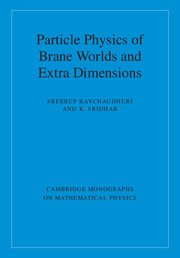Book contents
- Frontmatter
- Dedication
- Contents
- Preface
- 1 Dimensional dreams
- 2 The Standard Model and beyond
- 3 The birth of compact dimensions
- 4 String theory: a review
- 5 Effective theories
- 6 Large extra dimensions
- 7 Visible towers of invisible gravitons
- 8 Making black holes
- 9 Universal extra dimensions
- 10 Warped compactifications
- 11 Graviton resonances
- 12 Stability of warped worlds
- 13 Exploring the bulk
- 14 Epilogue
- Appendix A General Relativity in a nutshell
- Appendix B Testing the inverse-square law
- References
- Index
4 - String theory: a review
Published online by Cambridge University Press: 05 July 2016
- Frontmatter
- Dedication
- Contents
- Preface
- 1 Dimensional dreams
- 2 The Standard Model and beyond
- 3 The birth of compact dimensions
- 4 String theory: a review
- 5 Effective theories
- 6 Large extra dimensions
- 7 Visible towers of invisible gravitons
- 8 Making black holes
- 9 Universal extra dimensions
- 10 Warped compactifications
- 11 Graviton resonances
- 12 Stability of warped worlds
- 13 Exploring the bulk
- 14 Epilogue
- Appendix A General Relativity in a nutshell
- Appendix B Testing the inverse-square law
- References
- Index
Summary
Historical prelude
As we have already discussed in Chapter 1, it was with the idea of understanding strong interactions that string theory was proposed. The motivation for this, as we discussed, came from the attempt to derive the dynamics of strong interactions from the properties of the S-matrix, such as analyticity, unitarity and crossing symmetry. The amplitude proposed by Veneziano [63], which encrypted these properties of the S-matrix, led to the study of what came to be known as the dual model of hadrons. The realisation that the dynamics of the dual model could be obtained from relativistic strings led to a systematic study of string theory. Nambu [64] and, independently, Goto [65] proposed the form of the classical action for a string and the study of the theory as a model for hadrons was actively pursued. Eventually, this string picture of hadrons had to be abandoned because the spectrum of states of a closed string always contained a massless, spin-2 hadron which had never been observed. The theory also predicted tachyons and there were issues related to the consistency of the theory whose resolution required the theory to be a higher-dimensional theory.
Of course, the graviton perfectly fitted the description of a massless spin-2 particle and it was this observation that made Scherk and Schwarz [24] suggest a reinterpretation of string theory not as a theory of hadrons but as a theory of all interactions, which naturally incorporates gravity. The string scale was taken to be proportional to the Planck scale rather than hadronic scales so that the corrections to classical gravity coming from string theory would be at appropriate short-distance scales. Once it was taken seriously as a candidate for a unified theory of all interactions including gravity then the other problems plaguing the theory could be addressed. The early phase of string theory is reviewed in Refs. [66, 67]. Starting from the mid 1980s to the present, expositions of the developments in string theory have been presented in several excellent books and reviews. For a very incomplete, albeit select, list, see Refs. [68, 69, 70, 71, 72, 73].
- Type
- Chapter
- Information
- Particle Physics of Brane Worlds and Extra Dimensions , pp. 45 - 85Publisher: Cambridge University PressPrint publication year: 2016



